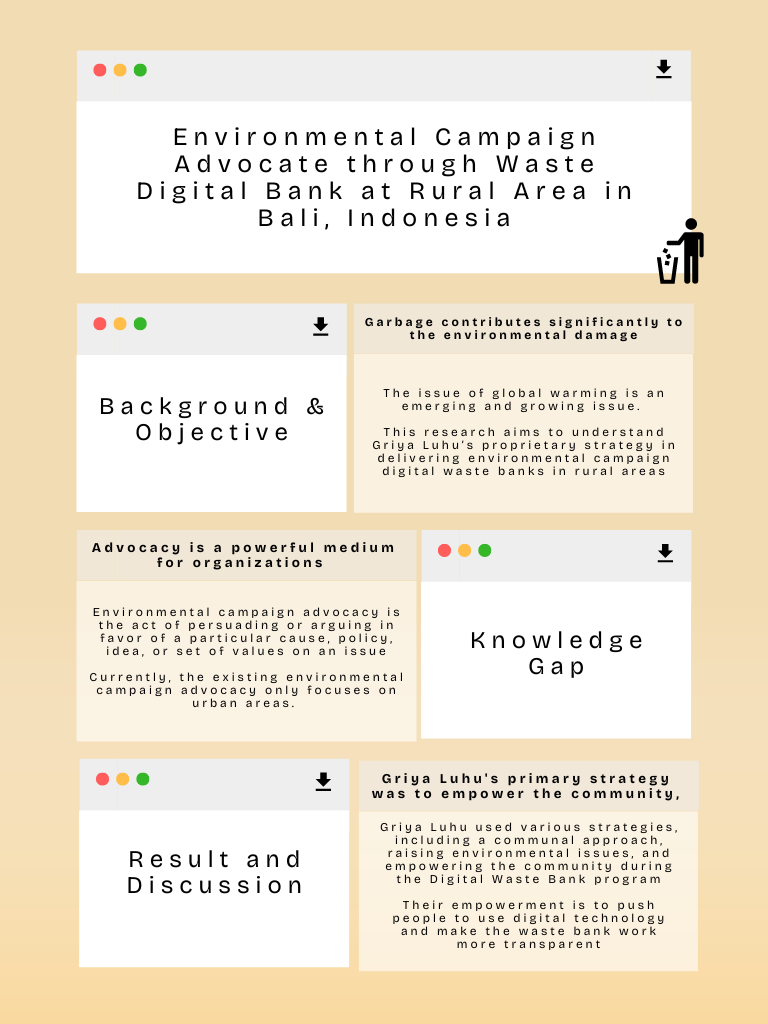Environmental Campaign Advocate through Waste Digital Bank at Rural Area in Bali, Indonesia
Abstract
Discussions about environmental issues, one that has become quite the topic of conversation this decade is related to global warming, for example related to waste. Garbage has a significant contribution to environmental damage. The issue of global warming is an emerging and growing issue. The purpose of the research is to understand the proprietary strategy of Griya Luhu's in delivering environmental campaign digital waste banks at Rural Area. Environmental communication is one of the advocacy efforts. Environmental campaign advocacy is the act of persuading or arguing in favor of a particular cause, policy, idea or set of values on an issue. Advocacy is a powerful medium for various social and environmental change organizations. Existing environmental campaign advocacy all this time only focuses on urban areas. Economic limitations and waste issues become the main reason why Griya Luhu, an NGO Bali-Indonesia based, wants to give environmental campaigns to rural communities on Bali island through their program called Digital Bank Sampah (Waste Digital Bank). This research is done with an in-depth interview with the Chairman dan members of Griya Luhu. The outcome of this research shows that Griya Luhu uses various strategies, including a communal approach, raising environmental issues, and empowering the community during the program Waste Digital Bank. Griya Luhu's primary strategy is empowering the community, especially in rural areas. The form of their empowerment is to push the people to be able to use digital technology and want to make waste bank work more transparent. Thus the community is more concerned with the environment, especially the problem of waste
References
Anggita, D. (2007). Kontribusi Sampah terhadap Pemanasan Global. Jakarta: Deputi Bidang Pengendalian Pencemaran - KLH.
CNN Indonesia. (2019, August 21). KLHK: 72 Persen Masyarakat Tak Peduli dengan Sampah Plastik. Diambil kembali dari https://www.cnnindonesia.com/teknologi/20190821164641-199-423470/klhk-72- persen-masyarakat-tak-peduli-dengan-sampah-plastik.
Creswell, J. W. (2013). Research Design Pendekatan Kualitatif, Kuantitatif, dan Mixed. Yogyakarta: Pustaka Pelajar.
Cox, R. (2010). Environmental Communication and the Public Sphere. Chape Hill: SAGE
Cox, R. (2012). Study and practice of Environmental Communication. Environmental Communication and the Public Sphere, 1, 11–38. http://www.sagepub.com/upm-data/47777_ch_1.pdf
Creswell, J. W. (2013). Research Design Pendekatan Kualitatif, Kuantitatif, dan Mixed. Yogyakarta: Pustaka Pelajar.
DLH Kulon Progo. (2017). Kajian Timbulan Sampah Harian Permukiman Kulon Progo. Kulon Progo: PT. Proporsi
Kamil, M. (1999). Prinsip-Prinsip dalam Hukum Lingkungan Internasional. Jurnal Hukum & Pembangunan, 29(2), 107. https://doi.org/10.21143/jhp.vol29.no2.553
Klöckner, C. A. (2013). A comprehensive model of the psychology of environmental behaviour-A meta-analysis. Global Environmental Change, 23(5), 1028–1038. https://doi.org/10.1016/j.gloenvcha.2013.05.014
Lewis, D. (2010). Nongovermental Organizations, Definition and History. International Encyclopedia of Civil Society, January 2010, 0–7. https://doi.org/10.1007/978-0-387-93996-4
Marshall, A. (2011, April 9). Holidays in Hell: Bali's Ongoing Woes. Retrieved from TIME: http://content.time.com/time/world/article/0,8599,2062604,00.html
Pezullo, P. C., & Cox, R. (2018). Environmental Communication and the Public Sphere. Sage Publications.
Stephen W. Littlejohn, Foss, K. A., & Oetzel, J. G. (2012). THEORIES OF HUMAN COMMUNICATION Eleventh Edition. In Waveland Press, Inc. (Vol. 53, Issue 95). https://doi.org/10.1017/CBO9781107415324.004
Susilo, R. K. D. (2012). Sosilogi Lingkungan dan Sumber Daya Alam. Jogjakarta: Ar-ruzz Media.
UN. (2022). Restoring our common home: Declaration for Stockholm+50. 2.
Wulandari, Y. F., & Gusfa, H. (2019). Pemberdayaan Komunikasi Lingkungan Hidup WALHI Pada Pileg 2014. Jika, 2(2), 13–31.
Authors

This work is licensed under a Creative Commons Attribution 4.0 International License.
Authors who publish with this journal agree to the following terms:
- Authors retain copyright and grant the journal right of first publication with the work simultaneously licensed under a Creative Commons Attribution License that allows others to share the work with an acknowledgement of the work's authorship and initial publication in this journal.
- Authors are able to enter into separate, additional contractual arrangements for the non-exclusive distribution of the journal's published version of the work (e.g., post it to an institutional repository or publish it in a book), with an acknowledgement of its initial publication in this journal.
- Authors are permitted and encouraged to post their work online (e.g., in institutional repositories or on their website) prior to and during the submission process, as it can lead to productive exchanges, as well as earlier and greater citation of published work (See The Effect of Open Access).






